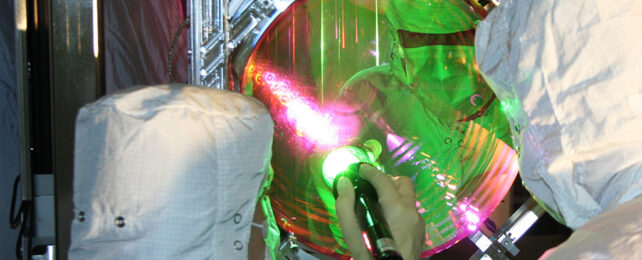Quantum science is usually concerned with ultra-small scales, where the mathematics of probability becomes a more useful tool than 'classical' descriptions of matter. Now, new research has put forward a way to measure the quantumness of much larger masses.
Scientists have been wanting to test the quantum nature of bigger objects for a long time: the general consensus is that quantum physics applies at every scale, but as objects grow in mass and complexity, their quantumness become harder to observe.
Now, a team from University College London (UCL), the University of Southampton in the UK, and the Bose Institute in India, has come up with an approach to quantum measurement that could theoretically be applied to something no matter what its mass or energy.
"Our proposed experiment can test if an object is classical or quantum by seeing if an act of observation can lead to a change in its motion," says physicist Debarshi Das from UCL.
Quantum physics describes a Universe where objects aren't defined by a single measurement, but as a range of possibilities. An electron can be spinning up and down, or have a high chance of existing in some areas more than others, for example.
In theory, this isn't limited to tiny things. Your own body can in effect be described as having a very high probability of sitting in that chair and a very (very!) low probability of being on the Moon.
There is just one fundamental truth to remember – you touch it, you've bought it. Observing an object's quantum state, whether an electron, or a person sitting in a chair, requires interactions with a measuring system, forcing it to have a single measurement.
There are ways to catch objects with their quantum pants still down, but they require keeping the object in a ground state – super-cold, super-still, completely cut off from its environment.
That's tricky to do with individual particles, and it gets a lot more challenging as the size of the scale goes up. The new proposal uses an entirely novel approach, one that uses a combination of assertions known as Leggett-Garg Inequalities and No-Signaling in Time conditions.
In effect, these two concepts describe a familiar Universe, where a person on a chair is sitting there even if the room is dark and you can't see them. Switching on the light won't suddenly reveal they're actually under the bed.
Should an experiment find evidence that somehow conflicts with these assertions, we just might be catching a glimpse of quantum fuzziness on a larger scale.
The team proposes that objects can be observed as they oscillate on a pendulum, like a ball at the end of a piece of string.
Light would then be flashed at the two halves of the experimental setup at different times – counting as the observation – and the results of the second flash would indicate if quantum behavior was happening, because the first flash would affect whatever was moving.
We're still talking about a complex setup that would require some sophisticated equipment, and conditions akin to a ground state – but through the use of motion and two measurements (light flashes), some of the restrictions on mass are removed.
"A crowd at a football match cannot affect the result of the game simply by staring strongly," says Das. "But with quantum mechanics, the act of observation or measurement itself changes the system."
The next step is to try this proposed setup in an actual experiment. The mirrors at the Laser Interferometer Gravitational-Wave Observatory (LIGO) in the US have already been proposed as suitable candidates for examination.
Those mirrors act as a single 10-kilogram (22-pound) object, quite a step up from the typical size of objects analyzed for quantum effects – anything up to about a quintillionth of a gram.
"Our scheme has wide conceptual implications," says physicist Sougato Bose from UCL. "It could extend the domain of quantum mechanics and probe whether this fundamental theory of nature is valid only at certain scales or if it holds true for larger masses too."
The research has been published in Physical Review Letters.
